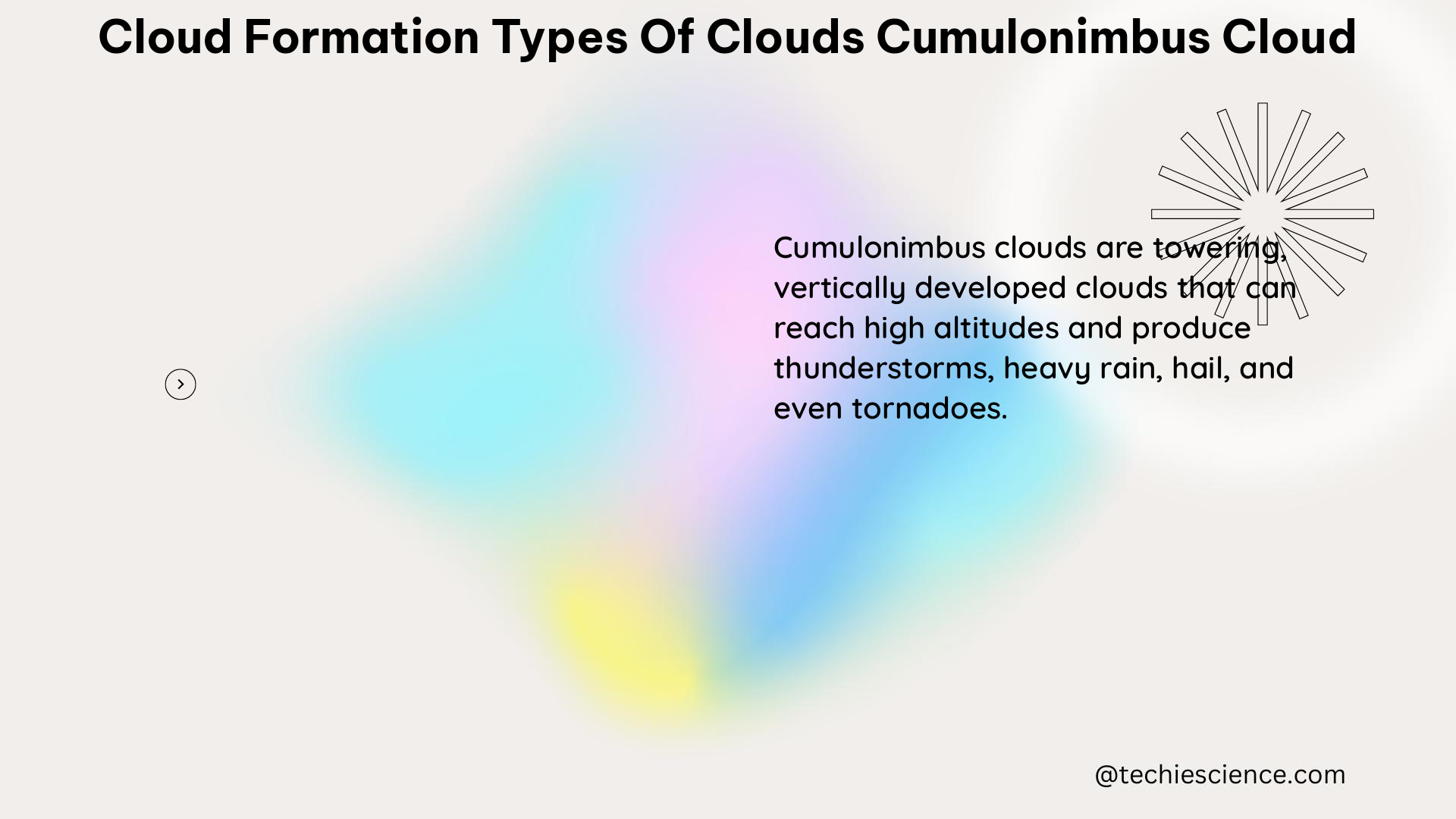Cumulonimbus clouds are a type of high-level cloud formation that can produce severe weather conditions, including heavy rain, hail, thunderstorms, and even tornadoes. These clouds are characterized by their towering, anvil-shaped appearance and their ability to store immense amounts of energy, equivalent to that of 10 Hiroshima-sized atom bombs. In this comprehensive guide, we will delve into the intricate details of cumulonimbus cloud formation, structure, and associated weather phenomena.
Height and Structure of Cumulonimbus Clouds
Cumulonimbus clouds are known for their impressive vertical development, with their bases typically ranging from 1,100 to 6,500 feet (335 to 1,980 meters) above the ground and their tops reaching up to 45,000 feet (13,700 meters), which is the top of the troposphere. This vast vertical extent allows these clouds to interact with different atmospheric layers, contributing to their complex and dynamic nature.
The shape of cumulonimbus clouds is equally distinctive, with their fibrous upper edges and anvil-shaped tops. This unique appearance is a result of the cloud’s continued growth and the interaction between the rising warm air and the surrounding cooler air.
Formation Mechanisms of Cumulonimbus Clouds

Cumulonimbus clouds form through two primary mechanisms: convection over a hot surface and forced convection along cold fronts.
Convection over a Hot Surface
When the Earth’s surface is heated by the sun, the air above it becomes warmer and less dense, causing it to rise. As the warm air rises, it cools and expands, leading to the formation of cumulus clouds. If the convection is strong enough, these cumulus clouds can continue to grow vertically, eventually transforming into cumulonimbus clouds.
Forced Convection along Cold Fronts
Cold fronts, which are boundaries between cold and warm air masses, can also trigger the formation of cumulonimbus clouds. As the cold front advances, the warm air ahead of it is forced to rise, leading to the development of a line of cumulonimbus clouds along the front.
The energy storage capacity of cumulonimbus clouds is truly remarkable. These clouds can store the same amount of energy as 10 Hiroshima-sized atom bombs, making them a formidable force in the atmosphere.
Weather Phenomena Associated with Cumulonimbus Clouds
Cumulonimbus clouds are closely associated with a variety of severe weather conditions, including:
Precipitation
Cumulonimbus clouds are known for their ability to produce heavy rain, hail, and thunderstorms. As the warm, moist air rises within the cloud, it cools and condenses, forming water droplets and ice crystals that eventually fall to the ground as precipitation.
Lightning and Thunderstorms
The vertical development of cumulonimbus clouds, combined with the presence of water droplets and ice crystals, creates an environment conducive to the generation of lightning and thunderstorms. The rapid updrafts within the cloud can separate positive and negative charges, leading to the buildup of electrical potential and the subsequent release of lightning.
Weather Duration
Individual cumulonimbus cells typically dissipate within an hour once showers start falling. However, in some cases, multicell or supercell storms can last much longer, posing a more persistent threat to the surrounding area.
Classification of Cumulonimbus Clouds
Cumulonimbus clouds can be further classified into three main species based on their appearance and stage of development:
-
Cumulonimbus calvus: These clouds have a puffy, cauliflower-like top, indicating that the water droplets within the cloud have not yet frozen.
-
Cumulonimbus capillatus: These clouds have a fibrous, cirrus-like top, signifying that the water droplets are starting to freeze and transform into ice crystals.
-
Cumulonimbus incus: These clouds have a distinct fibrous and anvil-shaped top, which indicates that the cloud is continuing to grow and develop, with the ice crystals in the upper regions spreading out horizontally.
Satellite Observation of Cumulonimbus Clouds
Satellite technology plays a crucial role in the observation and monitoring of cumulonimbus clouds. The GOES-16 (Geostationary Operational Environmental Satellite-16) satellite, equipped with the Advanced Baseline Imager (ABI), is particularly useful in this regard.
The ABI on GOES-16 can provide detailed information about the cloud-top features of cumulonimbus clouds, such as their height, temperature, and texture. This data helps scientists and meteorologists assess the potential size and severity of a storm, enabling more accurate forecasting and early warning systems.
Other Characteristics of Cumulonimbus Clouds
In addition to the previously mentioned details, cumulonimbus clouds have the following characteristics:
- Cloud Composition: Cumulonimbus clouds are composed of both water droplets and ice crystals, which contribute to their complex and dynamic nature.
- Cloud Classification: Cumulonimbus clouds are part of the “nimbus” family of clouds, indicating their association with rain or precipitation.
Conclusion
Cumulonimbus clouds are a fascinating and complex meteorological phenomenon, with their towering structure, immense energy storage, and ability to produce severe weather conditions. By understanding the intricate details of cumulonimbus cloud formation, structure, and associated weather patterns, we can better prepare for and respond to the challenges posed by these powerful atmospheric formations.
References

Hi, I am Sanchari Chakraborty. I have done Master’s in Electronics.
I always like to explore new inventions in the field of Electronics.
I am an eager learner, currently invested in the field of Applied Optics and Photonics. I am also an active member of SPIE (International society for optics and photonics) and OSI(Optical Society of India). My articles are aimed at bringing quality science research topics to light in a simple yet informative way. Science has been evolving since time immemorial. So, I try my bit to tap into the evolution and present it to the readers.
Let’s connect through